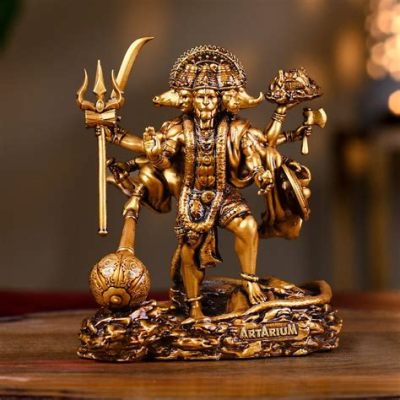The Story of Indra: A Tale Of Divine Intervention And Unlikely Friendships!

In the tapestry of Indonesian folklore, woven with threads of ancient beliefs and vibrant cultural nuances, lies the enchanting tale of “The Story of Indra.” This captivating narrative, originating in the 17th century, offers a glimpse into the complex relationship between humans and the divine, while highlighting the power of unlikely friendships.
“The Story of Indra” unfolds against a backdrop of rural Java, where life revolves around the rhythms of nature and the respect for ancestral spirits. The story centers on a young woodcutter named Joko, known for his honesty and unwavering kindness. One fateful day, while deep in the forest, Joko stumbles upon a magnificent golden sword gleaming amidst the undergrowth. Unbeknownst to him, this was no ordinary weapon; it belonged to Indra, the mighty king of the gods.
Joko, captivated by its beauty and intricate carvings, decides to keep the sword hidden beneath his humble hut. However, fate had other plans for him. That night, a blinding light floods Joko’s dwelling, and before him stands the imposing figure of Indra himself. Furious at the theft of his divine weapon, Indra threatens Joko with eternal punishment unless he returns the sword immediately.
Joko, trembling but determined to explain his innocent discovery, pleads with Indra for mercy. He narrates how he found the sword abandoned in the forest and had no intention of stealing it. Moved by Joko’s sincerity and the evident lack of malice, Indra softens. Recognizing Joko’s pure heart, he decides to test him further.
Indra proposes a challenge: if Joko can successfully complete three seemingly impossible tasks within a week, he will be granted not only forgiveness but also a reward beyond measure. Intrigued by this offer and eager to prove his worth, Joko accepts the daunting challenge.
The first task involves traveling to the summit of Mount Merapi, the most active volcano in Java, and retrieving a single blooming jasmine flower from its perilous slopes. Unfazed by the danger, Joko embarks on the treacherous journey, relying on his agility and sheer determination. He encounters ferocious beasts and scorching lava flows along the way, but his unwavering spirit guides him to the summit. There, amidst the volcanic ash and sulphurous fumes, he finds a lone jasmine flower miraculously blooming amidst the desolate landscape.
The second task demands that Joko retrieve a pearl from the depths of the Java Sea, guarded by a monstrous kraken with tentacles thicker than giant trees. Joko sets sail, facing towering waves and terrifying storms. He eventually encounters the kraken, using his wit and courage to distract the creature while stealthily retrieving the precious pearl.
For the final task, Indra instructs Joko to capture the elusive “Cenderawasih,” a mythical bird said to possess feathers that shimmer with all the colours of the rainbow. This task proves to be the most challenging, as the Cenderawasih is known for its swiftness and ability to vanish into thin air.
Joko embarks on an arduous quest through dense jungles and hidden valleys, encountering wise creatures and cunning traps. Finally, after weeks of relentless pursuit, he manages to catch the Cenderawasih using a trap crafted from bamboo and woven vines.
Returning to Indra with all three items, Joko humbly presents his bounty. Impressed by Joko’s resilience, ingenuity, and unwavering spirit, Indra rewards him not only with forgiveness but also with the gift of prosperity and wisdom. The golden sword, once a symbol of divine wrath, now serves as a reminder of Joko’s extraordinary journey and the power of perseverance in overcoming seemingly insurmountable odds.
“The Story of Indra” transcends its fantastical elements to deliver profound insights into the human experience. It emphasizes the importance of honesty, courage, and kindness, highlighting how these virtues can pave the way for unexpected rewards. The story also underscores the interconnectedness between humans and the divine, suggesting that even gods are capable of empathy and recognizing the worthiness in ordinary individuals.
The tale’s enduring appeal lies in its ability to transport readers to a world where myths intertwine with reality, and seemingly impossible feats become testaments to human strength and spirit. “The Story of Indra” continues to resonate with audiences centuries later, reminding us that even amidst hardship and adversity, hope and perseverance can lead to extraordinary outcomes.
Symbolism within the Tale:
| Symbol | Meaning |
|---|---|
| Golden Sword | Divine power, temptation, responsibility |
| Mount Merapi | Overcoming obstacles, resilience |
| Java Sea Kraken | Facing fears, conquering the unknown |
| Cenderawasih Bird | Pursuit of beauty, elusiveness of dreams |
| Joko’s Humble Hut | Simplicity, groundedness |
Through its intricate storytelling and rich symbolism, “The Story of Indra” offers a timeless message about the potential for greatness within each individual. It reminds us that even seemingly ordinary people can achieve extraordinary things when guided by honesty, courage, and unwavering faith in themselves.
